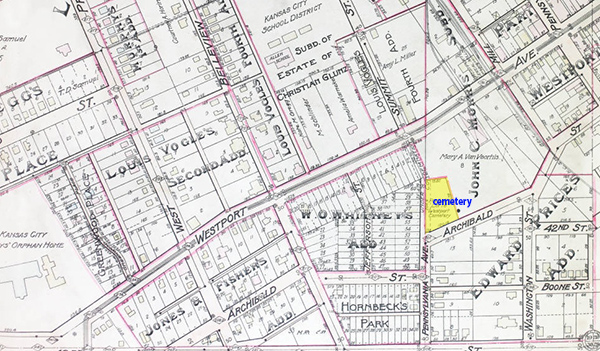
Some of Westport’s earliest settlers were laid to rest in a small cemetery at Pennsylvania and Archibald, now part of the bustling entertainment district. Established in 1835, the last grave was added around just three decades later as new cemeteries were built for the growing Kansas City.
In the early 1800s, the graves of a riverboat gambler, a rugged Indian agent, and prominent early settlers shared space in a small plot of land now in the middle of the Westport Entertainment District.
According to the Kansas City Times of May 30, 1970, “The Westport cemetery was established in 1835, when Edgar Price, an early day merchant, set aside a small plot of ground on Westport near Penn. Names of many once-prominent families were represented here, such as Heiskell, Carter, Guthrie, Spencer, Funk, Reagan, Wornall, Foster, Hamilton and Boone.”
Edmund Price “donated” the land for the 20-by-120 foot cemetery in 1835. It stood in a grove of locust trees. The Star in 1902 pieced together some of the names of those who had been buried there, including:
- Members of the Wornall family, including Mildred Wornall, young wife of a missionary to the Shawnee Indians, and G. Thomas Wornall, who died of cholera while he was in charge of a freighting expedition on the plains.
- Jerome Granville, whose tombstone said he died about 12 miles away in the Kansas Territory, “murdered by four Yankee Abolitionists.”
- Members of the Boone family, descendants of Kentucky pioneer Daniel Boone.
- Luke Lea, the oldest tombstone that remained, had been an Indian agent in Westport.
But by the turn of the 20th century, the burial ground was run down and old timers were already having trouble remembering the details. As more families staked out burial plots in larger places like Union Cemetery, opened in 1856, some of the bodies were removed.
Around that same time, a school teacher named Miss Mira Price, a descendant of Edgar Price, built a little fence around the cemetery and posted a no trespassing warning. She went to court arguing the grounds had deteriorated and that legally, an abandoned cemetery reverted to the original owners. As Midtown and all of Kansas City developed, the land became more valuable for buildings. Eventually the Badger Lumber Company took over the land.
In 1915, the Daughters of the American Revolution found the tombstone of Joseph Boggs, a lieutenant in the Revolutionary army and brother of an early governor of Missouri, on the site of the lumber yard. The stone was almost impossible to read after 94 years of exposure to the elements, but the ladies of the DAR had it embedded in the brick of the lumber company.
UPDATE: Our readers had lots of questions about what happened to the bodies in the cemetery. One of them, Stephen Porter, offered this information:
Do you have memories or more details about this area of Midtown? Please share them with our readers. Would you like us to focus on your block next week? Send us an email.
Our book, Kansas City’s Historic Midtown Neighborhoods, is available now at local bookstores and on Amazon.com. Let us know if you want us to come to your neighborhood association or organization’s meeting to share what we’ve learned about Midtown neighborhood history and tell your members how they can help preserve Midtown history.



Who’s talking